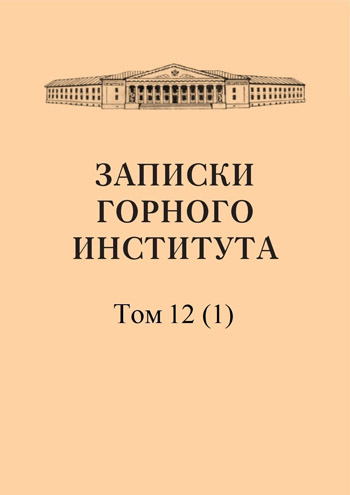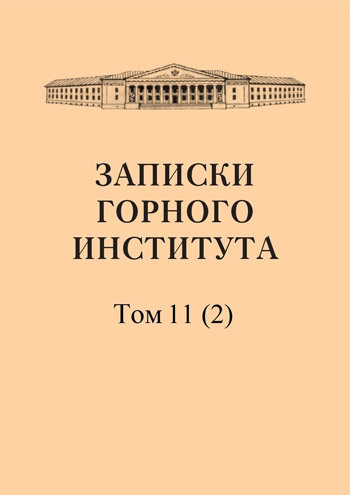-
Date submitted1937-09-14
-
Date accepted1937-11-09
-
Date published1938-03-01
About the steady state of a ball mill
- Authors:
- N. P. Neronov
In a previous work devoted to the theory of a cylindrical ball mill, I studied the initial period of unsteady motion of the balls. If the angular velocity of rotation of the drum remains constant, then the mode of the ball mill after some time can be considered steady, and the magnitude and direction of the speed of different balls passing through one and the same point in space do not change over time. We will talk about the outer row of balls. The same reasoning applies to other rows, if we make the assumption that the relative motion of the different rows is independent. This assumption, of course, requires additional research. The ball mill theory, which is usually used in practice, is approximate. The subject of this work is to refine the usual approximate theory of a ball mill.
-
Date submitted1937-09-28
-
Date accepted1937-11-23
-
Date published1938-03-01
About the theory of the drum separator and some of its analogies
- Authors:
- N. P. Neronov
The problem is to study the motion of a particle moving under the influence of gravity and in the presence of friction along the outer surface of a circular cylinder rotating around a horizontal axis. The problem under consideration finds application in some issues of mining and processing, namely in the theory of a drum separator, used for ore enrichment, as well as in the theory of a drum dumper, which is intended to unload material moved by a belt conveyor at a certain point. The results obtained make it possible to clarify the above theories, which are usually presented in technical manuals.
-
Date submitted1937-09-06
-
Date accepted1937-11-14
-
Date published1938-03-01
On the theory of material movement in screen and conveyors
- Authors:
- N. P. Neronov
One of the questions in the theory of screens and conveyors is the study of motion with friction. One of the questions in the theory of screens and conveyors is the study of motion with friction of a particle of material along a plane performing some movement, which in this work is considered predetermined. For this purpose, differential equations of material motion are compiled in the most general case of screen motion and then applied to the case of plane motion, which is of practical interest. Finally, some special cases of integrability of the resulting differential equation are indicated.
-
Date submitted1937-09-13
-
Date accepted1937-11-08
-
Date published1938-03-01
About vibrations of the inertial screen frame
- Authors:
- N. P. Malkin
In the previous work “On Inertial Screens,” I considered a vibrating screen as a system with three degrees of freedom, which corresponds to the assumption of the symmetry of all the masses of the screen and the forces applied to them relative to a certain vertical plane of symmetry intersecting with the screen sieve along the line of its greatest slope. The general case of small oscillations of an inertial screen, considered as a rigid body with all 6 degrees of freedom, is analyzed, and the conditions under which the problem can be reduced to three degrees of freedom are clarified (the case discussed in the previous article - “On inertial screens”). Euler's equations that determine the motion of a rigid body are simplified due to the smallness of its vibrations, and in a first approximation the problem is reduced to solving the System of 6 aggregate linear equations with constant coefficients or even to individual linear equations. If necessary, the result can be improved by successive approximation, also taking into account nonlinear terms."
-
Date submitted1937-09-21
-
Date accepted1937-11-26
-
Date published1938-03-01
Automation of compressor units driven by a synchronous motor
- Authors:
- F. N. Shklyarskii
Synchronous motors are currently started at both full and reduced voltage. 4 Regardless of the method used for starting a synchronous motor, the rotor of the latter, in addition to the excitation winding powered by a normally direct current, is also equipped with a short-circuited starting winding, which during the starting period turns the synchronous motor into an asynchronous one with a squirrel-cage rotor with the starting properties inherent in this motor. Both of these rotor windings, not being electrically connected to each other, during the start-up period represent, as it were, two independent secondary circuits participating in the creation of the torque developed by the engine. When the engine is running at full (synchronous) speed, the short-circuited starting winding plays the role of a damper winding. The synchronous motor can be started either at full or at reduced voltage. This article discusses the operations of automatic control of compressor units driven by a synchronous motor, which is started at full voltage; automatic protection of these installations from possible accidents is also provided.
-
Date submitted1937-09-13
-
Date accepted1937-11-08
-
Date published1938-03-01
Cases of accurate determination of the main parameters of a three-period mine hoisting tachogram
- Authors:
- F. I. Shklyarskii
Вполне точное определение отдельных параметров трехпериодной тахограммы рудничного подъема, как известно, имеет место при тахограмме, представляющей собою трапецию с прямолинейными боками. Ниже предлагаются точные методы определения элементов тахограммы для двух систем подъема, при наличии прямолинейных сторон для периода пуска t1, и соответственных криволинейных сторон для периода замедления t2. Точное определение отдельных элементов трехпериодной тахограммы возможно: 1) в случае прямолинейных ее сторон, соответствующих периодам пуска и замедления; 2) в случае наличия одной прямолинейной стороны, соответствующей периоду пуска, и другой, изменяемой по закону синуса или гиперболического синуса криволинейной стороны, соответствующей периоду замедления при обязательном условии, что искомым при этом является период пуска t1.
-
Date submitted1937-09-15
-
Date accepted1937-11-06
-
Date published1938-03-01
Cases of accurate determination of the main parameters of a three-period mine hoisting tachogram
- Authors:
- A. V. Podoprigora
Usually the task of a Wheatstone or Thomson bridge is to find such conditions, under certain given conditions, so that the sensitivity of the circuit is greatest. Meanwhile, it is known that when measuring large and very small resistances, the sensitivity of the circuit decreases, and it may happen that even the highest possible sensitivity at such resistances will be lower than required. Therefore, it seems interesting to find out what the lowest and highest resistances can be measured with the required relative accuracy on the Wheatstone or Thomson bridge and what the corresponding resistances in the remaining branches should be under certain given conditions. This article solves the problem of determining the minimum and maximum resistances measurable on the bridge with a given accuracy for a given maximum current sensitivity of the galvanometer and its internal resistance under the following conditions (see article). In addition, the article shows that when measuring low resistances, both bridges - Thomson and Wheatstone - can be used with equal success.
-
Date submitted1937-09-13
-
Date accepted1937-11-28
-
Date published1938-03-01
Processing magnetic survey data. Introduction of corrections for daily changes in the magnetic field
- Authors:
- N. A. Nikiforov
In magnetic exploration, in the process of measurements and processing, much attention is paid to taking into account daily changes (variations) of the magnetic field. Having compared the maximum amplitudes of daily changes in the magnetic field over a number of years and for a number of magnetic observatories, the author comes to conclusions that in some cases make it possible to partially exclude the influence of daily changes or not to introduce corrections due to their insignificant value.The conclusions can be characterized as follows (see article). Currently, magnetic observatories publish ten-day reviews of space data, which indicate the degree of disturbance in the Earth's magnetic field for each hour of each day. These surveys should be used to determine which days during field work there were significant magnetic disturbances and then correct for variations in observations made on these “stormy” days.


